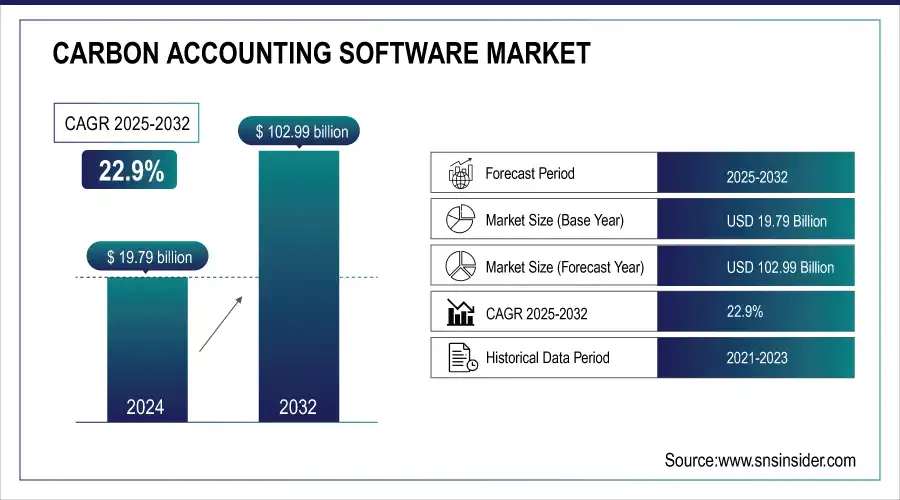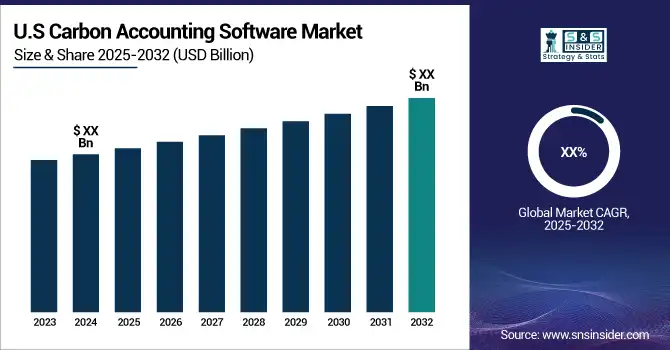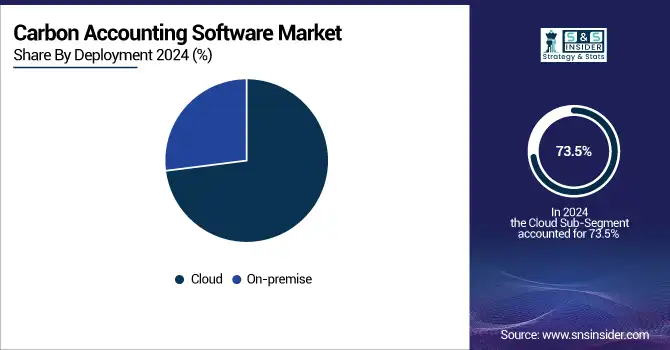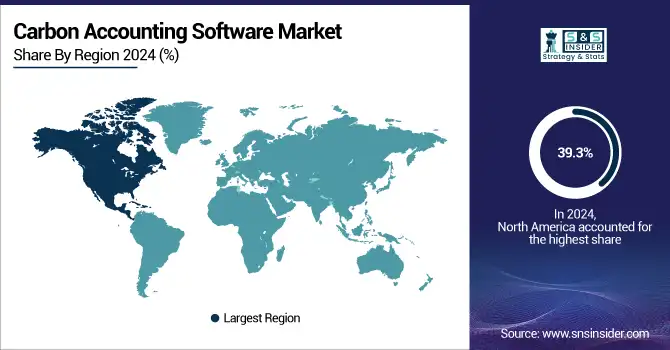Carbon Accounting Software Market Report Scope & Overview:
The Carbon Accounting Software Market was valued at USD 19.79 billion in 2024 and will reach USD 102.99 billion by 2032, growing at a CAGR of 22.9% by 2032.

Get more information on Carbon Accounting Software Market - Request Free Sample Report
The carbon accounting software market has seen rapid growth as organizations increasingly prioritize sustainability and regulatory compliance, driven by stringent global emissions regulations, corporate social responsibility (CSR) initiatives, and investor demand for transparent environmental reporting. For instance, nearly 80% of organizations surveyed in 2022 indicated that compliance with environmental regulations, like the Paris Agreement, was a key driver for implementing carbon accounting software. Carbon accounting software helps businesses track, report, and reduce their greenhouse gas emissions by calculating carbon footprints across their operations and supply chains.

Carbon Accounting Software Market Highlights:
-
Increasing regulatory pressure, particularly in the EU, U.S., and China, is driving adoption of carbon accounting software.
-
Investor expectations for sustainability and ESG criteria are encouraging businesses to implement carbon tracking solutions.
-
Rising consumer demand for eco-friendly products is pushing companies to showcase environmental responsibility using carbon accounting tools.
-
Technological advancements, including AI and machine learning, enhance software capabilities with real-time insights and predictive analytics.
-
Inconsistent global regulations and reporting frameworks pose challenges, increasing complexity and cost for multinational companies.
-
Growing alignment between consumer preferences and corporate sustainability goals is expected to further boost market growth.
Key growth factors include increasing regulatory pressure, particularly in regions like the European Union, which is tightening its carbon emissions rules. The EU’s Corporate Sustainability Reporting Directive (CSRD), for instance, will require companies to disclose detailed emissions data, further driving the adoption of such software. Additionally, countries like the U.S. and China are also introducing stricter climate policies, creating a global demand for solutions that support carbon tracking. Moreover, investor expectations for sustainability are rising. Environmental, Social, and Governance (ESG) criteria are increasingly critical for assessing a company's long-term sustainability. This encourages businesses to adopt carbon accounting tools to demonstrate environmental responsibility and attract investment. Companies like Salesforce and Microsoft have already introduced carbon management platforms, allowing their clients to track emissions in real-time and improve transparency. Technological advancements, including the integration of AI and machine learning in carbon accounting, are enhancing the software’s capabilities. AI can automate the tracking and reporting processes, offering real-time insights and predictive analytics, which improve decision-making and emission reduction strategies.
Carbon Accounting Software Market Drivers:
-
Rising consumer preference for eco-friendly brands drives businesses to adopt carbon reporting to highlight sustainability efforts.
Rising consumer demand for eco-friendly products is playing a key role in driving businesses to adopt carbon accounting software. As more consumers prioritize sustainability in their purchasing decisions, companies are under pressure to demonstrate their environmental responsibility. This has led businesses to integrate carbon tracking and reporting tools to highlight their efforts in reducing greenhouse gas emissions and minimizing their carbon footprint. Carbon accounting software enables companies to measure emissions across operations and supply chains, providing transparent data on their sustainability efforts. By adopting such solutions, businesses can showcase their commitment to eco-friendly practices, enhancing their brand image and appealing to environmentally-conscious consumers.
Looking ahead, this trend is expected to contribute significantly to the future growth of the carbon accounting software market. As consumer awareness of climate change increases, the demand for brands that prioritize sustainability will grow, pushing more companies to adopt carbon-tracking tools. The alignment of consumer preferences with corporate sustainability goals will continue to drive the need for advanced carbon accounting solutions.
Carbon Accounting Software Market Restraints:
-
Inconsistent global regulations and reporting frameworks make it difficult for companies to adopt a uniform carbon accounting approach.
Inconsistent global regulations and reporting frameworks present a significant challenge for companies adopting carbon accounting software. Different countries and regions have varying standards for emissions reporting, which complicates the process for businesses operating across multiple jurisdictions. For example, while the European Union has strict carbon disclosure requirements under initiatives like the CSRD, other regions may have less stringent or entirely different frameworks.
This lack of standardization makes it difficult for companies to adopt a uniform approach to carbon accounting. They often need to customize their reporting methods to meet diverse regulatory requirements, increasing the complexity and cost of implementing carbon management software. It also creates confusion about which metrics to prioritize and how to report emissions consistently. As a result, businesses may delay adopting carbon accounting tools until global regulations become more harmonized, limiting the market’s overall growth potential in the short term.
Carbon Accounting Software Market Segment Analysis
By Deployment
In 2024, the cloud segment dominated the market, capturing over 73.5% of global revenue. Cloud-based carbon accounting solutions offer organizations the flexibility to access tools from any location, allowing real-time emissions tracking and management across various sites. This is especially advantageous for businesses with distributed operations or remote teams. Moreover, cloud solutions minimize the need for large upfront IT investments, making them an appealing choice for small and medium-sized enterprises.
The on-premises segment is expected to register the highest CAGR during the forecast period. Organizations with strict data protection needs, like those in financial services, healthcare, and government, often opt for on-premises solutions to retain full control over their sensitive carbon emissions data. These deployments also offer more customization, enabling businesses to tailor solutions to their specific requirements and seamlessly integrate with existing IT systems. As regulatory demands increase and accurate carbon accounting becomes more critical, companies are investing in secure on-premises solutions to ensure compliance and protect proprietary information, driving strong growth in this segment over the forecast period.

By Enterprise Size
The large enterprises segment dominated the market and represented over 53.2% of market revenue in 2024. Large enterprises frequently operate across various regions and industries, necessitating sophisticated tools to effectively monitor and report their carbon emissions on a global scale. The demand for thorough compliance with environmental regulations, alongside the pressure to meet ESG standards, leads to substantial investments in advanced carbon accounting software. These solutions offer in-depth insights, customizable reporting options, and integration with broader enterprise systems, empowering large companies to manage their sustainability initiatives and maintain transparency with stakeholders more effectively.
The small and medium enterprises (SMEs) segment is projected to experience significant growth at a CAGR during the forecast period. As environmental regulations tighten, SMEs are increasingly turning to carbon accounting software to ensure compliance and improve their sustainability profiles. The increasing availability of cost-effective, user-friendly cloud-based solutions facilitates the implementation of these tools without requiring substantial upfront investments. Furthermore, the growing demand from consumers and partners for transparency in environmental practices is encouraging SMEs to invest in carbon management to stay competitive in the market.
By End-Use
In 2024, the energy and utilities segment generated the largest revenue share in the carbon accounting software market. As some of the highest greenhouse gas emitters, energy and utility companies face strict environmental regulations and reporting obligations. These organizations are under considerable pressure to minimize their carbon footprint and adopt more sustainable practices. Carbon accounting software equips them with the necessary tools to accurately monitor emissions throughout their operations, optimize energy consumption, and ensure compliance with environmental standards.
The transportation & logistics segment is expected to register the highest CAGR during the forecast period. As governments enforce stricter environmental regulations and carbon reduction targets, companies in this segment are increasingly required to adopt advanced carbon accounting software to monitor and manage their emissions more effectively. Additionally, the growth of green logistics initiatives, along with rising consumer demand for eco-friendly supply chains, is driving the industry toward more sustainable operations.
Carbon Accounting Software Market Regional Analysis:
North America Carbon Accounting Software Market Trends:
In 2024, North America dominated the market and represented a revenue share of 39.3%. The governments of the U.S. and Canada have established stringent reporting requirements for greenhouse gas emissions, prompting organizations across various sectors to adopt carbon accounting software. Furthermore, the increasing emphasis on ESG practices among North American companies has heightened the demand for advanced tools to monitor and report carbon emissions. The region's significant share of the market is also bolstered by the presence of major industry players and a high rate of technological adoption.

Need any customization research/data on Carbon Accounting Software Market - Enquiry Now
Asia-Pacific Carbon Accounting Software Market Trends:
The Asia Pacific carbon accounting software market is anticipated to experience rapid growth throughout the forecast period. With countries like China, India, and Japan introducing stricter environmental regulations and carbon reduction initiatives, businesses are increasingly adopting carbon accounting software to meet compliance requirements and minimize their environmental impact. For instance, the Indian government has launched a program to incentivize companies to adopt carbon footprint management practices. Carbon accounting software helps them track and manage their carbon footprint. On the other hand, the regulatory environment for carbon accounting varies across different countries in Asia Pacific, which can create challenges for companies operating in multiple regions.
Europe Carbon Accounting Software Market Trends:
Europe is a major adopter of carbon accounting software, driven by stringent environmental regulations such as the European Union’s Corporate Sustainability Reporting Directive (CSRD) and the EU Emissions Trading System (ETS). Companies across industries are increasingly required to report detailed greenhouse gas emissions and implement sustainability initiatives. The growing focus on ESG compliance and investor-driven sustainability expectations is further boosting demand. The presence of mature technology infrastructure and leading carbon accounting software providers in the region also supports market growth.
Latin America Carbon Accounting Software Market Trends:
Latin America’s carbon accounting software market is expected to grow steadily, supported by initiatives in countries like Brazil, Mexico, and Chile aimed at reducing carbon emissions and promoting environmental sustainability. Businesses are adopting carbon accounting tools to comply with emerging regulations and to attract ESG-focused investments. Brazil, in particular, is witnessing increased adoption due to governmental policies encouraging transparency in carbon footprint management. Nevertheless, economic variability and limited awareness among SMEs may slow market penetration in certain countries.
Middle East & Africa (MEA) Carbon Accounting Software Market Trends:
The MEA carbon accounting software market is gradually gaining traction, with countries such as the UAE, Saudi Arabia, and South Africa introducing sustainability and carbon reduction initiatives. The adoption is primarily driven by regulatory frameworks targeting corporate sustainability and government-backed green programs. Large corporations and energy-intensive industries are increasingly implementing carbon accounting solutions to monitor and reduce emissions. However, uneven regulatory enforcement and varying levels of technological infrastructure across the region can pose challenges to consistent adoption.
Carbon Accounting Software Market Key Players:
-
Climate Vault - (Carbon Offsetting, Climate Risk Assessment)
-
Carbon Tracker - (Carbon Disclosure, Climate Risk Analysis)
-
Persefoni - (Carbon Accounting, Climate Risk Management)
-
Climate Neutral Group - (Carbon Footprint Calculation, Carbon Offset Solutions)
-
Watershed - (Carbon Accounting, Climate Risk Management)
-
Climate Analytics - (Climate Risk Assessment, Climate Change Modeling)
-
Climate Action Tracker - (Climate Policy Tracking, Climate Target Analysis)
-
Coolset - (Carbon Footprint Calculation, Carbon Reduction Strategies)
-
Normative - (Carbon Footprint Calculation, Carbon Reduction Strategies)
-
Plan A - (Carbon Footprint Calculation, Carbon Reduction Strategies)
-
Emitwise - (Carbon Footprint Calculation, Carbon Reduction Strategies)
-
Sinai Technologies - (Carbon Accounting, Climate Risk Management)
-
Vaayu - (Carbon Footprint Calculation, Carbon Reduction Strategies)
-
Greenly - (Carbon Footprint Calculation, Carbon Offset Solutions)
-
Sustain Life - (Carbon Footprint Calculation, Carbon Reduction Strategies)
-
Pledge - (Carbon Footprint Calculation, Carbon Offset Solutions)
-
Sphera - (Carbon Accounting, Sustainability Management)
-
Intelex Technologies - (Carbon Accounting, Environmental Management)
-
Net0 - (Carbon Footprint Calculation, Carbon Reduction Strategies)
-
Evalue8 Sustainability - (Carbon Footprint Calculation, Carbon Reduction Strategies)
Carbon Accounting Software Market Competitive Landscape:
Engie, established in 2008 and headquartered in France, is a global energy company specializing in low-carbon electricity, natural gas, and energy services. The company focuses on renewable energy, energy efficiency solutions, and decarbonization projects, serving industrial, commercial, and residential clients worldwide to drive sustainable energy transitions.
- In May 2024, Engie, a French multinational utility company, partnered with a sustainability software provider to implement a cloud-based carbon accounting platform across its operations. This signifies a growing trend of large corporations adopting advanced carbon accounting solutions.
Schneider Electric, established in 1836 and headquartered in France, is a global leader in energy management and automation solutions. The company provides integrated hardware, software, and services to optimize energy usage, enhance operational efficiency, and support sustainability initiatives across industrial, commercial, and residential sectors worldwide
- In April 2024, Schneider Electric launched a new carbon accounting software solution specifically designed for small and medium-sized businesses (SMBs). This development indicates an expansion of the market to cater to the needs of a wider range of companies.
| Report Attributes | Details |
| Market Size in 2024 | USD 19.79 billion |
| Market Size by 2032 | USD 102.9 billion |
| CAGR | CAGR of 22.9% From 2024 to 2032 |
| Base Year | 2024 |
| Forecast Period | 2025-2032 |
| Historical Data | 2021-2023 |
| Report Scope & Coverage | Market Size, Segments Analysis, Competitive Landscape, Regional Analysis, DROC & SWOT Analysis, Forecast Outlook |
| Key Segments |
• By Deployment (Cloud-based and On-premise) |
| Regional Analysis/Coverage | North America (US, Canada), Europe (Germany, UK, France, Italy, Spain, Russia, Poland, Rest of Europe), Asia Pacific (China, India, Japan, South Korea, Australia, ASEAN Countries, Rest of Asia Pacific), Middle East & Africa (UAE, Saudi Arabia, Qatar, South Africa, Rest of Middle East & Africa), Latin America (Brazil, Argentina, Mexico, Colombia, Rest of Latin America). |
| Company Profiles | Climate Vault, Carbon Tracker, Persefoni, Climate Neutral Group, Watershed, Climate Analytics, Climate Action Tracker, Coolset, Normative, Plan A, Emitwise, Sinai Technologies, Vaayu, Greenly, Sustain Life, Pledge, Sphera, Intelex Technologies, Net0, Evalue8 Sustainability |

